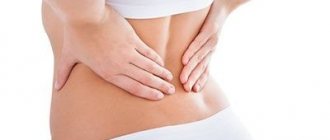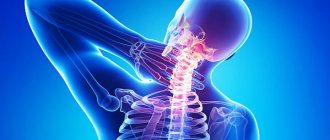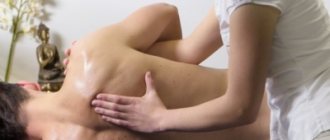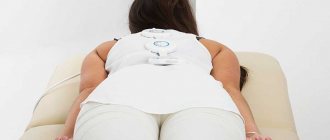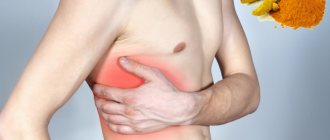Osteochondrosis is a chronic disease in which degenerative processes occur in the cartilage tissue of the intervertebral discs. At the initial stages, the thinning of the disc is compensated by the body, so painful sensations do not appear or the person has time to get used to them. Under the influence of provoking factors, an exacerbation of osteochondrosis occurs, in which the patient’s condition sharply worsens.
Exacerbation of osteochondrosis can be life-threatening for the patient, so self-medication in this condition is unacceptable. Neurologists at the Yusupov Hospital provide emergency care to patients with exacerbation of osteochondrosis, identify the causes of the development of the pathological condition and effectively eliminate the symptoms.
Causes of exacerbation of osteochondrosis
Osteochondrosis was previously a disease characteristic of older people. However, modern advances in science and technology have led to the disease being diagnosed in adolescents and young adults. The development of osteochondrosis can be accompanied by regular exacerbations, during which symptoms intensify and the habitual rhythm of a person’s life changes.
Exacerbation of osteochondrosis can be caused by one or more factors:
- emotional overload and chronic stress are the reasons why tissue nutrition is disrupted;
- prolonged stay in an uncomfortable or unnatural position;
- overheating or hypothermia;
- season;
- non-professional massage;
- colds;
- excessive loads during sports, professional activities, household loads;
- careless, sudden movements;
- alcohol consumption affects metabolic processes in the body and the psychological state of a person;
- cyclical changes in women during menstruation.
Stages of spinal osteochondrosis
Depending on the degree of development of the disease, there are four stages of spinal osteochondrosis , which are inherent in all types of osteochondrosis.
First stage of osteochondrosis
The main symptom of spinal osteochondrosis at the first stage is segmental instability of the spine caused by disorders in the intervertebral disc. This leads to ailments and discomfort, while there is no pain, but the spine is susceptible to injury.
Second stage of osteochondrosis
In the second stage (protrusion), the vertebrae are less well fixed to each other, the destruction of the ring begins, the intervertebral gaps decrease, and related problems appear.
Third stage of osteochondrosis
At the third stage of spinal osteochondrosis, destruction of the fibrous ring and the formation of a hernia are observed. Significant deformations of the spine already appear. The syndromes depend on the location of the hernia, its nature and mass.
In the fourth stage, it becomes difficult to move, and sudden movements lead to acute pain. Sometimes there is an illusion of improvement as the pain subsides. This occurs due to the formation of bone growths that connect nearby vertebrae. The consequence of this stage can even be disability.
Exacerbation of osteochondrosis: symptoms
If a patient experiences an exacerbation of osteochondrosis, the symptoms of this condition are determined by the location of the lesion. Experienced neurologists, when treating patients with characteristic complaints, determine in which part of the spine the pathological process develops. A comprehensive examination at the diagnostic center of the Yusupov Hospital using European equipment allows you to accurately determine the location of the lesion.
Pain during exacerbation of osteochondrosis can be localized in the cervical, thoracic or lumbar spine. When treating osteochondrosis, specialists at the Yusupov Hospital identify the causes that resulted in the complication and also effectively treat the symptoms.
Exacerbation of osteochondrosis of the cervical spine, the symptoms and treatment of which are determined by its localization, is manifested by intense pain in the back of the head and neck, which spreads to the chest or back. Patients with severe attacks experience a tingling sensation, goosebumps, and difficulty moving their fingers.
Pain localized in the back and side indicates an exacerbation of thoracic osteochondrosis. If left untreated, signs of the pathological process may persist for several weeks or months, so when the first symptoms appear, it is important to contact a qualified specialist.
Exacerbation of lumbar osteochondrosis may be accompanied not only by pain, but also by impaired sensitivity in the groin area. When osteochondrosis worsens, mobility is sharply limited and the functions of nearby organs are disrupted.
How to recognize thoracic osteochondrosis
Before recognizing thoracic osteochondrosis, it is necessary to exclude the possibility of developing pathology of internal organs, such as the heart, coronary circulatory system, lungs, pleura, bronchi, etc. Let's look at how to recognize osteochondrosis of the thoracic region:
- the most important diagnostic technique is palpation, if pain is determined exclusively by the spinous processes of the vertebrae and in the area of the paravertebral muscles, degenerative destruction of the cartilage tissue of the intervertebral discs is possible;
- mobility is limited and any turns and bends of the body increase pain;
- the attack of pain was provoked by physical exertion, hypothermia or psychological stress factors;
- When you take a deep breath, the pain does not get worse.
It is very important to know how to understand the heart or osteochondrosis, since acute chest pain is often a precursor to myocardial infarction. And in this condition, the patient should be immediately provided with cardiac care.
So, if during an attack of pain you feel anxiety, panic and fear of death, then there is a 90% probability of a heart attack and you need to urgently call an ambulance. If you have a tonometer, you need to measure your blood pressure and count your pulse. When the pulse slows to bradycardia (less than 50 beats per minute) and when the blood pressure level increases by 20 - 40 mm Hg above the age norm, an attack of unstable angina with possible progression to myocardial infarction should also be suspected.
You should not look for information on how to understand heart pain or osteochondrosis; it is much more productive to seek medical help. Even the most ordinary ECG taken in the hospital emergency department will show whether the pain is caused by the heart or the spinal column. You can independently rely only on the sensations during palpation. As a rule, when the heart muscle is damaged, palpation of the spinous processes of the vertebrae does not give any unpleasant sensations. But at the same time, there are such clinical symptoms as shortness of breath, a feeling of lack of air, pallor of the skin, a feeling of cold sticky sweat on the skin, cyanosis of the nasolabial triangle and severe muscle weakness.
Treatment of osteochondrosis during exacerbation at the Yusupov Hospital
When a patient comes to the Yusupov Hospital with complaints of acute osteochondrosis, treatment begins after a comprehensive diagnosis. The main task of specialists at the neurology clinic is to relieve symptoms caused by muscle spasm and inflammation. Non-steroidal anti-inflammatory drugs and B vitamins are effective treatments during this period.
In case of exacerbation of osteochondrosis, the patient is prescribed bed rest, the duration of which should not exceed 3 weeks, as the muscles lose their tone and atrophy. After relief of the condition, the patient gradually returns to normal life.
Effective methods of treating osteochondrosis are massages and physical therapy classes, which are carried out at the Yusupov Hospital by experienced rehabilitation doctors and exercise therapy trainers. However, the use of these methods is possible only after the signs of exacerbation have ceased.
The medical staff of the Yusupov Hospital provides a wide range of services for the diagnosis, treatment and prevention of diseases. One of the priorities of the medical institution is to provide emergency care to patients with various diseases, including spinal osteochondrosis. You can make an appointment with a specialist or find out about the operating hours of the Yusupov Hospital by phone or through the feedback form on the website.
What to do for pain from osteochondrosis
We figured out how to understand that pain arises from osteochondrosis. Now there is equally important information. You need to know how to behave correctly and what to do to get rid of such a disease.
Degenerative dystrophic disease of the cartilage tissue of the intervertebral discs does not go away on its own. This is due to a number of factors. First of all, calcification of the surface of the fibrous ring occurs, as a result of which it loses the ability to absorb fluid secreted by working muscles. Secondly, in the process of reducing the height of the intervertebral discs, a secondary contraction of ligaments and tendons occurs. It will be impossible to restore the height of the intervertebral spaces necessary for straightening the discs on your own.
What to do? Contact our manual therapy clinic for help. We begin treatment of osteochondrosis with manual traction of the spinal column. During this manipulation, compression from soft tissues and radicular nerves is eliminated. The pain syndrome goes away.
Then, with the help of osteopathy, massage, therapeutic exercises, kinesiotherapy, reflexology, physiotherapy and other techniques, a full course of rehabilitation therapy is carried out. It is developed individually for each patient. Therefore, if you need help in treating osteochondrosis, then sign up for a free appointment with a vertebrologist or neurologist at our manual therapy clinic right now.
Who most often experiences osteochondrosis?
Certain conditions contribute to spinal problems:
- Sedentary lifestyle, low physical activity. Office workers are at increased risk.
- Overweight. Every extra kilogram adds stress to the spinal column.
- Excessive physical activity. Overload during training in athletes.
- Poor nutrition. In order for the vertebrae, ligaments and muscles to be strong and withstand loads, they must receive the necessary substances - “building material”.
- Previous injuries to the neck, back, lower back.
- Untreated postural disorders, scoliosis.
- Constant stay, work in an uncomfortable forced position, when you often have to stand or sit bent over for a long time.
- If you have close relatives who have osteochondrosis, your risks are also increased.
Why does osteochondrosis occur?
Spinal osteochondrosis is a disease that does not have one specific cause. Various factors lead to its occurrence:
- Injuries. Osteochondrosis can become a loud echo of a previously suffered fracture or ligament damage.
- Microtraumas. They can be caused by frequent similar movements in the spinal column, prolonged stay in a monotonous uncomfortable position.
- Congenital anomalies of the spine. They are different: non-fusion of the vertebral arches, changes in the number of vertebrae in the lumbar and sacral region, incorrect location of the articular processes in the lumbar region. A person may not suspect his entire life that he has one of these conditions, and then, when his back “sicks,” the anomaly is revealed during an examination.
- Autoimmune conditions in which immune cells appear in the intervertebral discs and attack the body's own tissues.
- Circulatory disorders. The tissues of the spine stop receiving the required amount of oxygen-rich blood.
Consult a neurologist at the Medical Center International Clinic Medica24. A specialist doctor will establish the correct diagnosis, understand the causes of osteochondrosis, and prescribe effective treatment.
Symptoms of damage to the lumbosacral area
Anatomically, this area in women has a specific structure: the vertebrae LIV–LV are larger, wedge-shaped, this allows them to bear a fetus and give birth. The transition between the LI–LII and LV–SI vertebrae is more mobile, the lower back is more flexible than the male one. With dystrophic changes, she suffers more than men.
Compaction and thinning of the intervertebral discs manifests itself:
- diseases (or symptoms) of the genitourinary organs;
- lumbago in the legs, lower back, back;
- chronic pain of the affected area;
- spasmodic muscles;
- gait with dragging legs;
- low mobility of the knee and pelvic joints;
- numbness of the lower extremities.
Osteopathic diagnosis of osteochondrosis
To make a diagnosis, the osteopath uses several testing options:
- Passive and active testing;
- Fascial tension test;
- Tensile testing;
- Axial load tests;
- Craniosacral rhythm test.
During such a diagnosis, the patient undergoes a detailed comprehensive examination of the flexibility and elasticity of the vertebrae and the tissues connecting them, and the degree of their damage. The weakest points of the spinal column are identified.
At the same time, the osteopath detects deviations in the position of internal organs and changes in their size, if the stage of the disease is such that it can cause it.
The study helps to find tension in muscle tissue that interferes with their normal functioning. Also during diagnosis, the doctor determines the degree of wear of the intervertebral discs.
